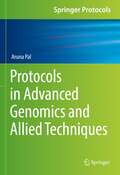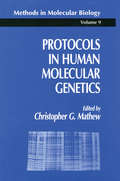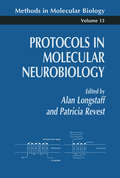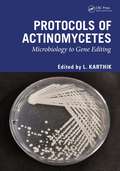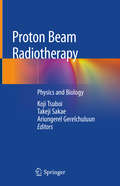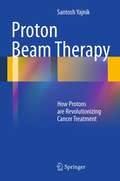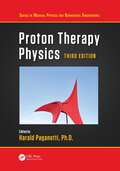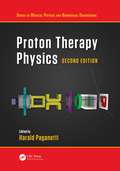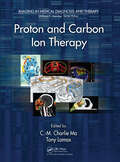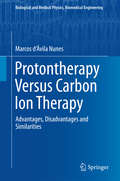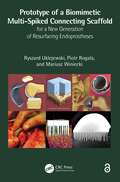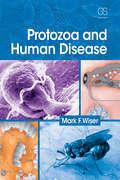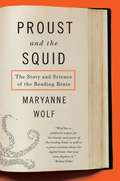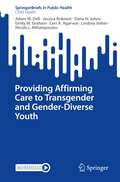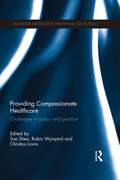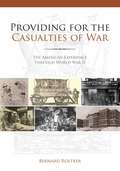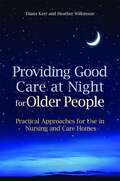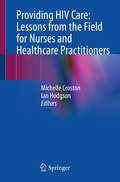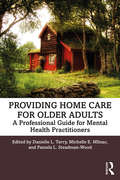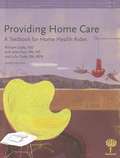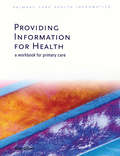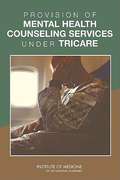- Table View
- List View
Protocols in Advanced Genomics and Allied Techniques (Springer Protocols Handbooks)
by Aruna PalThis laboratory manual includes the latest tools and techniques involved in genomic research. It starts with an introductory chapter on genomics and the various tools and applications involved. The initial chapters present protocols for basic techniques such as DNA isolation, electrophoresis, PCR, cDNA synthesis etc. The book then goes on to describe more advanced techniques such as next-generation sequencing, exome sequencing, use of RNAi, RNAseq, genome editing, single cell genomics etc. Each topic includes a brief description, information on the principles involved, materials & methods, protocol, and expected results, with diagrams and graphs. All protocols are presented in a very lucid and precise way, to make it easy for readers to follow and replicate them.
Protocols in Human Molecular Genetics
by Christopher G. MathewProtocols in Human Molecular Genetics highlights the tremendous advances in our ability to work on the human genome that have emerged in the past few years. The latest techniques are set forth in the clear, concise, easy-to-follow format that is the hallmark of Humana's Methods in Molecular Biology series. Nearly two-thirds of the book is devoted to describing practical procedures comprising the widest range of new methodologies in human molecular genetics, with the rest focusing on their specific experimental and clinical applications. An essential tool for everyone-whether novice or seasoned expert-involved in the rapidly growing area of human genome studies.
Protocols in Molecular Neurobiology
by Patricia Revest Alan LongstaffEach chapter identifies a problem in neurobiology, showing how the solution of that problem will advance knowledge in the field. The approaches taken to solve the problem are clearly explained, providing sufficient detail for users to readily reproduce the technique and its results. In keeping with the goal of the series, each technique is designed to work, even the first time it is used.
Protocols of Actinomycetes: Microbiology to Gene editing
by L. KarthikMany of the natural products have been isolated and characterized from the actinobacteria, for example polyketides, phenazines, peptides, indolocarbarbazoles, and sterols. To explore new antibiotics from actinobacteria, several bioinformatics and synthetic biology tools were developed. This book covers basics to recent protocols for drug discovery from actinobacteria.Features: Discusses the benefits of production of antibiotics and enzymes from actinomycetes in a large scale Covers the synthetic biology approach Describes the strain improvement of actinobacteria Gives information on basic isolation of actinobacteria and modern techniques Covers the applications and metabolic engineering strategies of actinomycetes This book will be helpful for the pharmaceutical industries and researchers to develop new antibiotics from actinobacteria and can be used in support of future research in drug discovery.
Proton Beam Radiotherapy: Physics and Biology
by Koji Tsuboi Takeji Sakae Ariungerel GerelchuluunThis book offers a comprehensive, practical guide to understanding the physical and biological characteristics of proton beam radiotherapy. The application of proton beams to the treatment of solid cancers has expanded exponentially over the last decade due to their physical properties, which make it possible to administer higher doses of radiation to lesions with only a minimum dose to the surrounding healthy tissues. Accordingly, understanding the basic aspects of proton beam radiotherapy is a primary concern not only for medical physicists and radiation biologists, but also for all physicians involved in cancer treatment using proton beams. The major aspects discussed include the technique’s development background, the generation and delivery system for proton beams, physical characteristics, biological consequences, dosimetry, and future prospects in both medical physics and radiation biology in terms of effective cancer treatment. Gathering contributions from experts who provide clear and detailed information on the basics of proton beams, the book will greatly benefit not only radiological technicians, medical physicists, and physicians, but also scientists in cancer radiotherapy.
Proton Beam Therapy
by Santosh YajnikProton beam therapy is an emerging technology with promise of revolutionizing the treatment of cancer. While nearly half of all patients diagnosed with cancer in the US receive radiation therapy, the majority is delivered via electron accelerators, where photons are used to irradiate cancerous tissue. Because of the physical properties of photon beams, photons may deposit energy along their entire path length through the body. On the other hand, a proton beam directed at a tumor travels in a straight trajectory towards its target, gives off most of its energy at a defined depth called the Bragg peak, and then stops. While photons often deposit more energy within the healthy tissues of the body than within the cancer itself, protons can deposit most of their cancer-killing energy within the area of the tumor. As a result, in the properly selected patients, proton beam therapy has the ability to improve cure rates by increasing the dose delivered to the tumor and simultaneously reduce side-effects by decreasing the dose to surrounding tissue. The benefits of proton beam therapy in delivering a lethal hit to the target while sparing surrounding normal tissues from radiation are becoming applicable to an increasing number of patients and a growing list of conditions. In this book, the author will guide the reader through existing evidence supporting proton beam therapy for pediatric cancer, prostate cancer, lung cancer, brain tumors, spinal tumors, and several other conditions. The book will discuss which conditions are suitable for treatment with proton beam therapy, how the treatment is delivered, and the current data supporting its use.
Proton Therapy Physics (Series in Medical Physics and Biomedical Engineering)
by Harald PaganettiExpanding on the highly successful previous two editions, this third edition of Proton Therapy Physics has been updated throughout and includes several new chapters on “Adaptive Proton Therapy,” "Imaging for Planning,” “Flash Proton Therapy,” and “Outcome Modeling for Patient Selection.” Suitable for both newcomers in medical physics and more seasoned specialists in radiation oncology, this book provides an in‑depth overview of the physics of this radiation therapy modality, eliminating the need to dig through information scattered across medical physics literature.After tracing the history of proton therapy, this book explores the atomic and nuclear physics background necessary for understanding proton interactions with tissue. The text then covers dosimetry, including beam delivery, shielding aspects, computer simulations, detector systems, and measuring techniques for reference dosimetry. Important for daily operations, acceptance testing, commissioning, quality assurance, and monitor unit calibrations are outlined. This book moves on to discussions of imaging for planning and image guidance as well as treatment monitoring. Aspects of treatment planning for single‑ and multiple‑field uniform doses, dose calculation concepts and algorithms, and precision and uncertainties for nonmoving and moving targets are outlined. Finally, the biological implications of using protons from a physics perspective as well as outcome modeling are discussed.This book is an ideal practical guide for physicians, dosimetrists, radiation therapists, and physicists who already have some experience in radiation oncology. It is also an invaluable reference for graduate students in medical physics programs, physicians in their last year of medical school or residency, and those considering a career in medical physics.Key Features:• Updated with the latest technologies and methods in the field, covering all delivery methods of proton therapy, including beam scanning and passive scattering.• Discusses clinical aspects, such as treatment planning and quality assurance.• Offers insight into the past, present, and future of proton therapy from a physics perspective.Dr. Harald Paganetti is a distinguished figure in the field of radiation oncology, serving as Professor of Radiation Oncology at Harvard Medical School and Director of Physics Research at Massachusetts General Hospital. He earned his PhD in experimental nuclear physics from the Rheinische‑Friedrich‑Wilhelms University in Bonn, Germany, in 1992.
Proton Therapy Physics, Second Edition (Series in Medical Physics and Biomedical Engineering)
by Harald PaganettiExpanding on the highly successful first edition, this second edition of Proton Therapy Physics has been completely restructured and updated throughout, and includes several new chapters. Suitable for both newcomers in medical physics and more seasoned specialists in radiation oncology, this book provides an in-depth overview of the physics of this radiation therapy modality, eliminating the need to dig through information scattered across medical physics literature. After tracing the history of proton therapy, the book explores the atomic and nuclear physics background necessary for understanding proton interactions with tissue. The text then covers dosimetry, including beam delivery, shielding aspects, computer simulations, detector systems and measuring techniques for reference dosimetry. Important for daily operations, acceptance testing, commissioning, quality assurance and monitor unit calibrations are outlined. The book moves on to discussions of treatment planning for single- and multiple-field uniform doses, dose calculation concepts and algorithms, and precision and uncertainties for nonmoving and moving targets. Imaging for treatment guidance as well as treatment monitoring is outlined. Finally, the biological implications of using protons from a physics perspective are discussed. This book is an ideal practical guide for physicians, dosimetrists, radiation therapists, and physicists who already have some experience in radiation oncology. It is also an invaluable reference for graduate students in medical physics programs, physicians in their last year of medical school or residency, and those considering a career in medical physics. Features: Updated with the latest technologies and methods in the field, covering all delivery methods of proton therapy, including beam scanning and passive scattering Discusses clinical aspects, such as treatment planning and quality assurance Offers insight on the past, present, and future of proton therapy from a physics perspective
Proton and Carbon Ion Therapy (Imaging in Medical Diagnosis and Therapy)
by C.-M. Charlie Ma Tony LomaxProton and Carbon Ion Therapy is an up-to-date guide to using proton and carbon ion therapy in modern cancer treatment. The book covers the physics and radiobiology basics of proton and ion beams, dosimetry methods and radiation measurements, and treatment delivery systems. It gives practical guidance on patient setup, target localization, and trea
Protontherapy Versus Carbon Ion Therapy
by Marcos D'Ávila NunesThis book presents a comparison analysis of two cancer treatment therapies: carbon ion therapy and protontherapy. It is divided in 5 sections. The first ones gives the reader a brief history of Radiotherapy and types of radiation. In the second section, the techniques and equipments, including new ones in development such as Cyclinac , Laser and DWA, are described. The third section describes biophysical (such as stopping power and LET) and biological (such as RBE and OER) properties, the fundamental experiments and clinical area. The fourth section presents models and the fifth section compares both techniques, showing advantages and disadvantages of each, and their similarities.
Prototype of a Biomimetic Multi-Spiked Connecting Scaffold for a New Generation of Resurfacing Endoprostheses
by Ryszard Uklejewski Piotr Rogala Mariusz WinieckiThe monograph comprehensively presents the research on the prototype of the biomimetic Multi-Spiked Connecting Scaffold (MSC-Scaffold) for cementless fixation of the components of a new generation of resurfacing arthroplasty (RA) endoprostheses. This research, carried out by a bioengineering-surgical team from three Polish universities, includes bioengineering design, rapid prototyping, manufacturing in selective laser melting, functionalization, surface modification, numerical studies, experimental in vitro studies, and pilot surgical experiments in an animal model. Features: Presents the prototype of the multi-spiked connecting scaffold for a new generation of resurfacing endoprostheses of the knee and the hip Explains this prototype scaffold as the first worldwide design of the biomimetic fixation of components of diarthrodial joints resurfacing endoprostheses Insights into the entire process of bioengineering design and research on this novel way of resurfacing endoprostheses fixation Reviews main results of the scaffold prototyping and SLM manufacturing, structural and osteoconductive functionalization, and surface modification Reports experimental and numerical investigations of mechanical behavior of the scaffold-bone system, cell culture studies, and pilot surgical experiments in animal models This book is aimed at professionals and graduate students in biomedical engineering, biomaterials engineering, and bone & joint surgery. The Open Access version of this book, available at http://www.taylorfrancis.com, has been made available under a Creative Commons [Attribution-Non Commercial-No Derivatives (CC-BY-NC-ND)] 4.0 license.
Protozoa and Human Disease
by Mark F WiserProtozoa and Human Disease is a textbook on medically important protozoa and the diseases they cause for advanced undergraduate students, graduate students, and professionals. It combines a taxonomic and medical approach and is therefore suitable for a parasitology, microbiology, medical, and public health readership. In addition to the basics such as morphological features, life cycles, and the clinical manifestations of the diseases, topics like the molecular and immunological basis of pathogenesis, metabolic pathways, specialized subcellular structures, ecology of disease transmission, antigenic variation, and molecular epidemiology are discussed for many of the protozoan pathogens. At the end of the book is an extensive glos
Proust and the Squid: The Story and Science of the Reading Brain
by Maryanne WolfMany scholars believe that humans are hard-wired for language, but no one, points out Wolf (child development, Tufts U.), believes that about reading and writing. The act of reading is not natural, she argues, either for a child or in the evolution of the brain's capacity to learn. She loves it anyway, and here shares her knowledge and joy at learning to read in both evolutionary and development contexts; she also explores reasons that some people cannot learn to read. By the way, Proust says they were just friends; the squid is not commenting.
Providing Affirming Care to Transgender and Gender-Diverse Youth (SpringerBriefs in Public Health)
by Adam W. Dell Jessica Robnett Dana N. Johns Emily M. Graham Cori A. Agarwal Lindsey Imber Nicole L. MihalopoulosThis book aids clinicians in supporting and caring for transgender and gender-diverse children and adolescents – youth who are born into an incongruent body. A recent study using data from 19 states reported that 1.8% of American youth identified as transgender. Many people who are transgender will experience gender dysphoria, the intense emotional distress that is caused by a discrepancy between a person's gender identity and their sex assigned at birth. In this compact volume, the authors discuss the variety of domains involved in addressing gender dysmorphia: social, psychological, medical, and legislative/advocacy. They provide clear and concise information on the types and timing of gender-affirming medications and surgical interventions and offer useful suggestions for making interactions in the clinic and the clinical space inclusive for transgender and gender-diverse youth. Among the topics covered include:identity development and gender nonconformity in early childhood and pubertythe importance of access to mental health professionals with expertise in gender nonconformitythe responsible use of developmentally appropriate gender-affirming medications and surgical interventionsrelated clinical issues such as nutrition counselling for youth receiving gender-affirming treatmentscreating a safe and inclusive healthcare environment for transgender and gender-diverse youthadvocating for transgender and gender-diverse patients by working with local and national policy makersProviding Affirming Care to Transgender and Gender-Diverse Youth is essential reading for pediatric healthcare professionals including physicians in pediatrics and family medicine, plastic surgeons, nurses, dietitians, psychiatrists, psychologists, social workers, and other practitioners. Students in these fields as well as policy makers also would find this a useful resource.
Providing Compassionate Healthcare: Challenges in Policy and Practice
by Sue Shea Robin Wynyard Christos LionisDespite the scope and sophistication of contemporary health care, there is increasing international concern about the perceived lack of compassion in its delivery. Citing evidence that when the basic needs of patients are attended to with kindness and understanding, recovery often takes place at a faster level, patients cope more effectively with the self-management of chronic disorders and can more easily overcome anxiety associated with various disorders, this book looks at how good care can be put back into the process of caring. Beginning with an introduction to the historical values associated with the concept of compassion, the text goes on to provide a bio-psycho-social theoretical framework within which the concept might be further explained. The third part presents thought-provoking case studies and explores the implementation and impact of compassion in a range of healthcare settings. The fourth part investigates the role that organizations and their structures can play in promoting or hindering the provision of compassion. The book concludes by discussing how compassion may be taught and evaluated, and suggesting ways for increasing the attention paid to compassion in health care. Developing a multi-disciplinary theory of compassionate care, and underpinned by empirical examples of good practice, this volume is a valuable resource for all those interesting in understanding and supporting compassion in health care, including advanced students, academics and practitioners within medicine, nursing, psychology, allied health, sociology and philosophy.
Providing For The Casualties Of War: The American Experience Through World War Ii
by Bernard RostkerWar has always been a dangerous business, bringing injury, wounds, and death, and--until recently--often disease. What has changed over time, most dramatically in the last 150 or so years, is the care these casualties receive and who provides it. This book looks at the history of how humanity has cared for its war casualties and veterans, from ancient times through the aftermath of World War II.
Providing Good Care at Night for Older People
by Diana Kerr Heather WilkinsonThe experiences and needs of residents and patients in nursing and care homes are very different at night, and this is particularly true for those with dementia. Yet nursing and care homes are not always inspected with the same rigour at night as they are during the day, and night staff do not always receive the same levels of training, resources and supervision as day staff. This book provides night staff, their managers and anyone else with an interest in care homes during the night with the information, knowledge and practical skills they need to deliver positive and appropriate care at night. The authors look at all of the issues that are particularly pertinent in caring for older people at night, including nutrition and hydration, continence, challenging behaviour, medication, night time checking, pain management and end of life care. They also look at the impact that working at night has on care staff, and offer practical suggestions to help them to safeguard their own health. The final chapter provides a set of night time care guidelines for inspectors that can also be used by managers to evaluate night time practices in their homes. This book is essential reading for night staff and their managers and employers, as well as inspectors of services, policy makers, and anyone else with an interest in the provision of care for older people.
Providing HIV Care: Lessons from the Field for Nurses and Healthcare Practitioners
by Michelle Croston Ian HodgsonThis very first book helps nurses and healthcare practitioners working in the field of HIV care across European to have practical examples of how they could improve/ adapt their services to improve outcomes for people living with HIV. It provides the reader with both knowledge on a variety of different HIV related topic areas and also helps them to translate this learning into a clinical setting. The main focus of the book is to share best practice in HIV nursing, with the aim of providing a practical guide from multiple countries to improve outcomes for people living with HIV. The book also acts as a resource to healthcare practitioners who are interested in working in many places in the world or carrying out research in HIV care.
Providing Healthy and Safe Foods As We Age: Workshop Summary
by Institute of Medicine of the National AcademiesDoes a longer life mean a healthier life? The number of adults over 65 in the United States is growing, but many may not be aware that they are at greater risk from foodborne diseases and their nutritional needs change as they age. The IOM's Food Forum held a workshop October 29-30, 2009, to discuss food safety and nutrition concerns for older adults.
Providing Home Care for Older Adults: A Professional Guide for Mental Health Practitioners
by Danielle L. TerryA practical guide to providing home-based mental health services, Providing Home Care for Older Adults teaches readers how to handle the unique aspects of home-based care and apply and adapt evidence-based assessment and treatment within the home-based setting. Featuring contributions from experienced, board-certified home care psychologists, social workers, and psychiatrists, the book explains the multifaceted role of a home-based provider, offers concrete and practical considerations for working within the home, and highlights adaptations to specific evidence-based methods used in treating homebound older adults. Also covered are special topics related to hoarding, safety, capacity evaluations, caregivers, case management, and use of technology. Each chapter includes engaging case examples with practical tips that illustrate what it is like to work in this new and exciting frontier. Psychologists, counselors, and other mental health practitioners in home settings will be able to use this guide to provide effective home-based care to older adults.
Providing Home Care: A Textbook for Home Health Aides (4th Edition)
by William Leahy Jetta Fuzy Julie GrafeThe book presents content that reflects state and federal training requirements, OSHA regulations, and current CDC guidelines and "Green" material that discusses ways to be environmentally friendly.
Providing Information for Health: A Workbook for Primary Care
by Alan GilliesThis stimulating and challenging work explores how to place consumers in charge to facilitate good patient care. It provides a coherent account of how customer/supply and demand/supply relationships work and identifies and describes the principles of good medical care and the approaches that can be taken to offer a credible and realistic agenda for change. This book is essential reading for policy makers and shapers healthcare managers and all those with an interest in the role of patients in healthcare.
Providing Support to Young People: A Guide to Interviewing in Helping Relationships
by Hazel L. Reid Alison J. FieldingThis is an invaluable guide to making the most of helping relationships. It concentrates on the practicalities and explores how to structure the help practitioners give to young people. Including case studies, reflective exercises, and dialogue examples that illustrate the model and use of skills, chapters cover: the context for youth support services and what ‘professional helping’ and youth support roles involve the practical development of the helping skills and strategies required by a practitioner concepts from various counselling models that have particular relevance for helping young people and discussing ‘hard to reach’ young people the stages of Egan’s skilled helper model in some depth, applying it particularly to youth support work. Describing an accessible ‘how-to’ approach to engaging with young people, this book will be essential reading to all those working in information, advice, guidance and youth support settings, whether giving first-in-line or intensive support to young people.
Providing Sustainable Mental and Neurological Health Care in Ghana and Kenya: Workshop Summary
by Engineering Medicine National Academies of SciencesMental, neurological, and substance use (MNS) disorders have a substantial impact on global health and well-being. Disorders such as depression, alcohol abuse, and schizophrenia constitute about 13 percent of the total burden of disease. Worldwide, MNS disorders are the leading cause of disability, and the 10th leading cause of death. Despite this high burden, there is a significant shortage of resources available to prevent, diagnose, and treat MNS disorders. Approximately four out of five people with serious MNS disorders living in low- and middle-income countries do not receive needed health services. This treatment gap is particularly high in Sub-Saharan Africa (SSA). Challenges to MNS care in SSA countries include a lack of trained mental health professionals, few mental health facilities, and low prioritization for MNS disorders in budget allocations. African countries, on average, have one psychiatrist for every 2 million people, whereas European countries have one psychiatrist per 12,000 people. Expanding on previous efforts to address the development and improvement of sustainable mental health systems in SSA, the Institute of Medicine convened this 2015 workshop series, bringing together key stakeholders to examine country-specific opportunities to improve the health care infrastructure in order to better prevent, diagnose, and treat MNS disorders. Providing Sustainable Mental and Neurological Health Care in Ghana and Kenya summarizes the presentations and discussions from these workshops.
Provision of Mental Health Counseling Services Under Tricare
by Institute of Medicine of the National AcademiesIn this book, the IOM makes recommendations for permitting independent practice for mental health counselors treating patients within TRICARE--the DOD's health care benefits program. This would change current policy, which requires all counselors to practice under a physician's supervision without regard to their education, training, licensure or experience.
